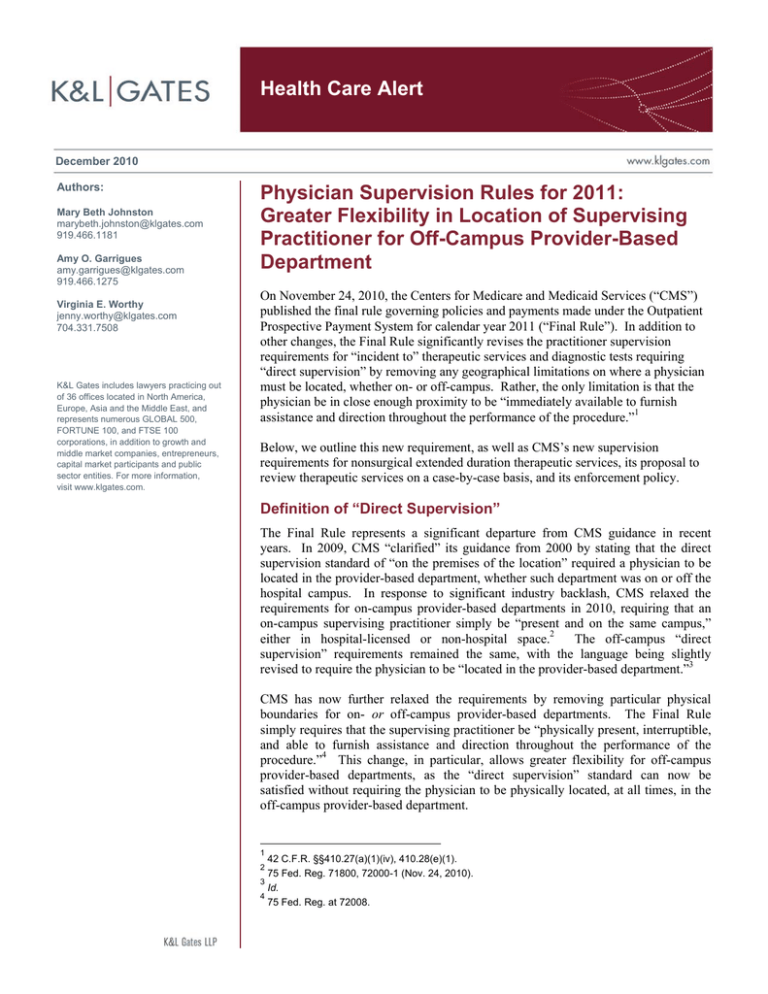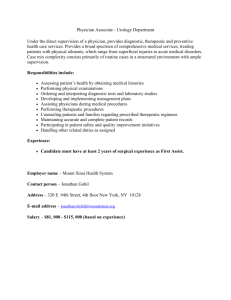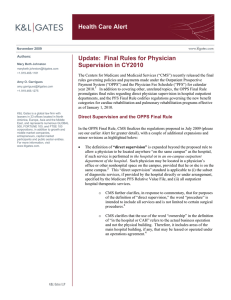
Health Care Alert
December 2010
Authors:
Mary Beth Johnston
marybeth.johnston@klgates.com
919.466.1181
Amy O. Garrigues
amy.garrigues@klgates.com
919.466.1275
Virginia E. Worthy
jenny.worthy@klgates.com
704.331.7508
K&L Gates includes lawyers practicing out
of 36 offices located in North America,
Europe, Asia and the Middle East, and
represents numerous GLOBAL 500,
FORTUNE 100, and FTSE 100
corporations, in addition to growth and
middle market companies, entrepreneurs,
capital market participants and public
sector entities. For more information,
visit www.klgates.com.
Physician Supervision Rules for 2011:
Greater Flexibility in Location of Supervising
Practitioner for Off-Campus Provider-Based
Department
On November 24, 2010, the Centers for Medicare and Medicaid Services (“CMS”)
published the final rule governing policies and payments made under the Outpatient
Prospective Payment System for calendar year 2011 (“Final Rule”). In addition to
other changes, the Final Rule significantly revises the practitioner supervision
requirements for “incident to” therapeutic services and diagnostic tests requiring
“direct supervision” by removing any geographical limitations on where a physician
must be located, whether on- or off-campus. Rather, the only limitation is that the
physician be in close enough proximity to be “immediately available to furnish
assistance and direction throughout the performance of the procedure.”1
Below, we outline this new requirement, as well as CMS’s new supervision
requirements for nonsurgical extended duration therapeutic services, its proposal to
review therapeutic services on a case-by-case basis, and its enforcement policy.
Definition of “Direct Supervision”
The Final Rule represents a significant departure from CMS guidance in recent
years. In 2009, CMS “clarified” its guidance from 2000 by stating that the direct
supervision standard of “on the premises of the location” required a physician to be
located in the provider-based department, whether such department was on or off the
hospital campus. In response to significant industry backlash, CMS relaxed the
requirements for on-campus provider-based departments in 2010, requiring that an
on-campus supervising practitioner simply be “present and on the same campus,”
The off-campus “direct
either in hospital-licensed or non-hospital space.2
supervision” requirements remained the same, with the language being slightly
revised to require the physician to be “located in the provider-based department.”3
CMS has now further relaxed the requirements by removing particular physical
boundaries for on- or off-campus provider-based departments. The Final Rule
simply requires that the supervising practitioner be “physically present, interruptible,
and able to furnish assistance and direction throughout the performance of the
procedure.”4 This change, in particular, allows greater flexibility for off-campus
provider-based departments, as the “direct supervision” standard can now be
satisfied without requiring the physician to be physically located, at all times, in the
off-campus provider-based department.
1
42 C.F.R. §§410.27(a)(1)(iv), 410.28(e)(1).
75 Fed. Reg. 71800, 72000-1 (Nov. 24, 2010).
3
Id.
4
75 Fed. Reg. at 72008.
2
Health Care Alert
CMS reiterated that the supervising practitioner
must also have within his or her state scope of
practice and hospital privileges the knowledge,
skills, ability, and privileges to perform the
procedure and to clinically redirect the service or
provide additional orders, if necessary.5
Nonsurgical Extended Duration
Therapeutic Services: A Different
Standard
CMS also finalized its earlier proposal to adopt a
different supervision requirement for a new set of
services, known as “nonsurgical extended duration
therapeutic services,” or extended duration services.
Such services are defined as lasting “a significant
period of time, [having] a substantial monitoring
component that is typically performed by auxiliary
personnel, [having] a low risk of requiring the
physician’s
or
appropriate
nonphysician
practitioner’s immediate availability after the
initiation of the service, and…not primarily surgical
in nature.”6 CMS mandates direct supervision for
the “initiation” of these services, which ends “when
the patient is stable and the supervising physician or
appropriate nonphysician practitioner believes the
remainder of the service can be delivered safely
under general supervision.”7 The term “stable” is
not defined, though CMS clarified that the definition
of “stable” under the Emergency Medical Treatment
and Labor Act does not apply for purposes of the
supervision rules.8 Accordingly, the time that a
patient is transferred to “general supervision” is a
clinical judgment by the applicable practitioner.
Hospitals
should
ensure
that
appropriate
documentation is maintained in the medical record
or progress notes to demonstrate that the practitioner
has made this determination.9
In the Final Rule, CMS selected 16 services to
include in the new category, including observation,
intravenous infusion, and therapeutic, prophylactic,
or diagnostic injections. According to CMS, these
types of services meet the requirements of the
definition; in other words, they have a tendency to
last for a long period of time, consist largely of
monitoring patients and have a low risk that a
physician’s physical presence will be necessary
CMS excluded
once the patient is stable.10
chemotherapy and blood transfusion services from
this list, asserting that these services have a high
probability that a physician’s or nonphysician
practitioner’s recurrent physical presence would be
necessary to evaluate the patient’s condition in
order to redirect the service.11
Independent Evaluation of Individual
Therapeutic Services
CMS is establishing a process to provide for
independent review and evaluation of the
appropriate level of supervision for all therapeutic
services on a service-by-service basis.12 CMS states
further that it is considering using the CMS Federal
Advisory Panel on Ambulatory Classification
Groups as the independent technical committee.13
CMS is requesting comments and recommendations
on the formation of an advisory panel and the
criteria that should be used for determining
appropriate levels of supervision for outpatient
therapeutic services for the 2012 calendar year.
Enforcement
Finally, CMS reiterates its statement from its 2009
commentary that it will exercise discretion and
decline to enforce the rule when noncompliance
between 2000 and 2008 resulted from “error or
mistake.”14 In response to continuing concerns
voiced by the rural community, the Final Rule
extends non-enforcement of direct supervision
requirements for therapeutic services to both critical
access hospitals and small rural hospitals with 100
or fewer beds for 2011.15
10
75 Fed. Reg. at 72004.
75 Fed. Reg. at 72011.
12
75 Fed. Reg. at 72006.
13
Id.
14
75 Fed. Reg. at 72012.
15
75 Fed. Reg. at 72007. The initial notice of nonenforcement issued on March 15, 2010 applied to CAHs. See
75 Fed. Reg. at 72002.
11
5
75 Fed. Reg. at 72012.
42 C.F.R. §410.27(a)(1)(v)(A).
7
42 C.F.R. §410.27(a)(1)(v)(B).
8
75 Fed. Reg. at 72003.
9
75 Fed. Reg. at 72011.
6
December 2010
2
Health Care Alert
Anchorage Austin Beijing Berlin Boston Charlotte Chicago Dallas Dubai Fort Worth Frankfurt Harrisburg Hong Kong London
Los Angeles Miami Moscow Newark New York Orange County Palo Alto Paris Pittsburgh Portland Raleigh Research Triangle Park
San Diego San Francisco Seattle Shanghai Singapore Spokane/Coeur d’Alene Taipei Tokyo Warsaw
Washington, D.C.
K&L Gates includes lawyers practicing out of 36 offices located in North America, Europe, Asia and the Middle East, and represents numerous
GLOBAL 500, FORTUNE 100, and FTSE 100 corporations, in addition to growth and middle market companies, entrepreneurs, capital market
participants and public sector entities. For more information, visit www.klgates.com.
K&L Gates comprises multiple affiliated entities: a limited liability partnership with the full name K&L Gates LLP qualified in Delaware and
maintaining offices throughout the United States, in Berlin and Frankfurt, Germany, in Beijing (K&L Gates LLP Beijing Representative Office), in
Dubai, U.A.E., in Shanghai (K&L Gates LLP Shanghai Representative Office), in Tokyo, and in Singapore; a limited liability partnership (also named
K&L Gates LLP) incorporated in England and maintaining offices in London and Paris; a Taiwan general partnership (K&L Gates) maintaining an
office in Taipei; a Hong Kong general partnership (K&L Gates, Solicitors) maintaining an office in Hong Kong; a Polish limited partnership (K&L
Gates Jamka sp.k.) maintaining an office in Warsaw; and a Delaware limited liability company (K&L Gates Holdings, LLC) maintaining an office in
Moscow. K&L Gates maintains appropriate registrations in the jurisdictions in which its offices are located. A list of the partners or members in each
entity is available for inspection at any K&L Gates office.
This publication is for informational purposes and does not contain or convey legal advice. The information herein should not be used or relied upon
in regard to any particular facts or circumstances without first consulting a lawyer.
©2010 K&L Gates LLP. All Rights Reserved.
December 2010
3






